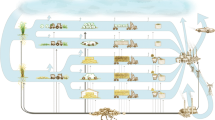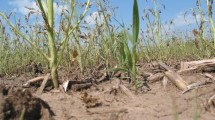Abstract
In the USA, biomass crop systems will be needed to meet future ethanol production goals. We estimated production costs, profits, and energy budgets for three potential crop systems for the Upper Midwest: continuous corn with stover harvest, an alfalfa–corn rotation with stover harvest, and switchgrass. Production costs, profits, and on-farm energy use were greatest for continuous corn, less for alfalfa–corn, and least for switchgrass. Energy to transport crops was similar for all crop systems. Both energy used to produce ethanol and energy output in ethanol was greatest for continuous corn, less for alfalfa–corn, and least for switchgrass. Co-product energy output was 32% greater for alfalfa–corn than continuous corn and 42% greater than switchgrass. Net energy produced (outputs–inputs) was greatest for switchgrass, followed by continuous corn, and then alfalfa–corn. Efficiency of energy production (outputs/inputs) was greatest for switchgrass, followed by alfalfa–corn, and then continuous corn. Our analysis emphasizes tradeoffs among crop systems. Corn may produce high rates of ethanol and net energy, but will do so least efficiently and with the greatest erosion and N leaching. Corn may have the greatest production costs, but return the greatest profit. Comparatively, alfalfa–corn will produce less ethanol and net energy, but will do so more efficiently, and with less erosion and little N leaching. Production costs, but also profits, may be less for alfalfa–corn than continuous corn. Switchgrass may produce the most net energy and will do so most efficiently and with the least erosion, but will also yield the least ethanol. Nitrogen leaching will be less for switchgrass than corn, but greater than alfalfa–corn. Switchgrass may be the least expensive to produce, but may return a profit only if selling prices or yields are high.

Similar content being viewed by others
References
Andraski TW, Bundy LG, Brye KR (2000) Crop management and corn nitrogen rate effects on nitrate leaching. J Environ Qual 29:1095–1103
Berg RD, Carter DL (1980) Furrow erosion and sediment losses on irrigated cropland. J Soil Water Conserv 35:267–270
Bransby DI, Smith HA, Taylor CR, Duffy PA (2005) Switchgrass budget model: an interactive budget model for producing and delivering switchgrass to a bioprocessing plant. Ind Biotechnol 1:122–125
Brannstrom AJ (2006) Wisconsin agricultural land prices 2000–2005. UW Center for Dairy Profitability. Available via http://cdp.wisc.edu/pdf/Wisconsin%20Agricultural%20Land%20Prices2.pdf. Cited 11 December 2007
DiCostanzo A, Zender CM, Akayezu JM, Jorgensen MA, Cassidy JM, Allen DM, Standorf DG, Linn JG, Jung H, Smith LJ, Lamb GC, Johnson D, Chester-Jones H, Robinson G (1999) Use of alfalfa leaf meal in ruminant diets. Proceedings of the 60th Minnesota Nutrition Conference and ZinPro Technical Symposium, Bloomington, Minnesota, 20–22 September 1999, pp 64–75
Dinnes DL, Karlen DL, Jaynes DB, Kasper TC, Hatfield JL, Colvin TS, Cambardella CA (2002) Nitrogen management strategies to reduce nitrate leaching in tile-drained Midwestern soils. Agron J 94:153–171
Duffy MD, Nanhou VY (2002) Costs of producing switchgrass for biomass in southern Iowa. Trends new crops new uses. ASHS Press, Alexandria, Virginia
Epplin FM (1996) Cost to produce and deliver switchgrass biomass to an ethanol-conversion facility in the southern plains of the United States. Biomass Bioenergy 11:459–467
Farrell AE, Plevin RJ, Turner BT, Jones AD, O’Hare M, Kammen DM (2006) Ethanol can contribute to energy and environmental goals. Science 311:506–508
Fisk JW, Hesterman OB, Shrestha A, Kells JJ, Harwood RR, Squire JM, Sheaffer CC (2001) Weed suppression by annual legumes cover crops in no-tillage corn. Agron J 93:319–325
Frank G (2003) Agricultural budget calculation software (ABCS), V. 7.1. Center for Dairy Profitability. University of Wisconsin, Madison
Gaynor JD, Findlay WI (1995) Soil and phosphorus loss from conservation and conventional tillage in corn production. J Environ Qual 24:734–741
Glassner D, Hettenhaus J, Schechinger T (1998) Corn stover collection project. Proceedings of the BioEnergy ‘98 Expanding Bioenergy Partnerships, vol 2, Madison, Wisconsin
Graham RL, Nelson R, Sheehan J, Perlack RD, Wright LL (2007) Current and potential U.S. corn stover supplies. Agron J 99:1–11
Hallam A, Anderson IC, Buxton DR (2001) Comparative economic analysis of perennial, annual, and intercrops for biomass production. Biomass Bioenergy 21:407–424
Halvorson AD, Mosier AR, Reule CA, Bausch WC (2006) Nitrogen and tillage effects on irrigated continuous corn yields. Agron J 98:63–71
Hill J, Nelson E, Tilman D, Polasky S, Tiffany D (2006) Environmental, economic, and energetic costs and benefits of biodiesel and ethanol. Proc Natl Acad Sci 103:11206–11210
Hipple PC, Duffy MD (2002) Farmers’ motivations for adoption of switchgrass. In: Janick J, Whipkey A (eds) Trends in new crops and new uses. ASHS Press, Alexandria, VA
Kim S, Dale BE (2002) Allocation procedure in ethanol production system from corn grain: I. System expansion. Int J Life Cycle Assess 7:237–243
Kim S, Dale BE (2004) Cumulative energy and global warming impact from the production of biomass for bio-based products. J Ind Ecol 7:147–162
Laboski CAM, JB Peters, Bundy LG (2007) Nutrient application guidelines for field, vegetable, and fruit crops in Wisconsin. Available via http://learningstore.uwex.edu/pdf/A2809.pdf. Cited 14 September 2007
Lal R (1998) Soil erosion impact on agronomic productivity and environment quality. Crit Rev Plant Sci 17:319–464
Lamb JFS, Sheaffer CC, Samac DA (2003) Population density and harvest maturity effects on leaf and stem yield in alfalfa. Agron J 95:635–641
Lamb JFS, Jung HJG, Sheaffer CC, Samac DA (2007) Alfalfa leaf protein and stem cell wall polysaccharide yields under hay and biomass management systems. Crop Sci 47:1407–1415
Mallarino AP, Ortiz-Torres E (2006) A long-term look at crop rotation effects on corn yield and response to nitrogen fertilization. Proceedings of the 18th Annual Integrated Crop Management Conference, Iowa State University, Ames, 29–30 November 2006
McLaughlin SB, Walsh ME (1998) Evaluating environmental consequences of producing herbaceous crops for bioenergy. Biomass Bioenergy 14:317–324
Morrow WR, Griffin WM, Matthews HS (2006) Modeling switchgrass derived cellulosic ethanol distribution in the United States. Environ Sci Technol 40:2877–2886
Parrish DJ, Fike JH (2005) The biology and agronomy of switchgrass for biofuels. Crit Rev Plant Sci 24:423–459
Patzek TW (2004) Thermodynamics of the corn–ethanol biofuels cycle. Crit Rev Plant Sci 23:519–567
Perlack RD, Wright LL, Turhollow AF, Graham RL, Stokes B, Erbach DC (2005) Biomass as feedstock for a bioenergy and bioproducts industry: the technical feasibility of a billion-ton annual supply. Available via http://www.ornl.gov/∼webworks/cppr/y2001/rpt/123021.pdf. Cited 14 September 2007
Randall GW, Huggins DR, Russelle MP, Fuchs DJ, Nelson WW, Anderson JL (1997) Nitrate losses through subsurface tile drainage in conservation reserve program, alfalfa, and row crop systems. J Environ Qual 26:1240–1247
Ronning R (1995) Leaf and stem fractionating and separating hammermill for dry fibrous products. US Patent 2,148,14, 6 June 1995
Rotz CA, Coiner CU (2006) Integrated farm system model: reference manual. USDA Agricultural Research Service, University Park, Pennsylvania
Rotz CA, Taube F, Russelle MP, Oenemad J, Sanderson MA, Wachendorf M (2005) Whole-farm perspectives of nutrient flows in grassland agriculture. Crop Sci 45:2139–2159
Schroeder JW (2003) Distillers grains as a protein and energy supplement for dairy cattle. North Dakota State Extension Service. North Dakota State University, Fargo
Schmer MR, Vogel KP, Mitchell R, Perrin RK (2006) Switchgrass management effects on feedstock costs in the northern great plains. Abstracts of the ASA, CSSA, SSSA Annual Meeting. Indianapolis, Indiana, 12–16 November 2006
Sedorovich DM, Rotz CA Vadas PA, Harmel RD (2007) Simulating management effects on phosphorus loss from farming systems. Trans ASABE 50:1443–1453
Shaffer MJ, Halvorson AD, Pierce FJ (1991) Nitrate leaching and economic analysis package (NLEAP): model description and application. In: Follett RF, Deeney DR, Cruse RM (eds) Managing nitrogen for groundwater quality and farm profitability. Soil Science Society of America, Inc., Madison, Wisconsin, pp 285–298
Shapouri H, Duffield JA, Wang M (2003) The energy balance of corn ethanol revisited. Trans ASAE 46:959–968
Sheaffer CC, Martin NP, Lamb JS, Cuoma GR, Jewett JG, Quering SR (2000) Leaf and stem properties of alfalfa entries. Agron J 92:733–739
Sheehan J, Aden A, Paustian K, Killian K, Brenner J, Walsh M, Nelson R (2004) Energy and environmental aspects of using corn stover for fuel ethanol. J Ind Ecol 7:117–146
Shinners KJ, Boettcher GC, Muck RE, Weimer PJ, Casler MD (2006) Drying, harvesting and storage characteristics of perennial grasses as biomass feedstocks. Paper number 061012, 2006 ASAE Annual Meeting
Shinners KJ, Herzmann ME, Binversie BN, Digman MF (2007) Harvest fractionation of alfalfa. Trans ASABE 50:713–718
Sokhansanj S, Turhollow AF (2002) Baseline cost for corn stover collect. Appl Eng Agric 18:525–530
Toth JD, Fox RH (1998) Nitrate losses from a corn–alfalfa rotation: lysimeter measurement of nitrate leaching. J Environ Qual 27:1027–1033
Turhollow A (2000) Costs of producing biomass from riparian buffer strips. Available via http://www.ornl.gov/∼webworks/cpr/v823/rpt/108548.pdf. Cited 14 September 2007
USDOE (2007) Theoretical ethanol yield calculator. Available via http://www1.eere.energy.gov/biomass/ethanol_yield_calculator.html. Cited 14 September 2007
Venuto BC, Daniel JA (2005) First year biomass production from CRP acreage in western Oklahoma. Proceedings of the American Forage and Grassland Council Conference Proceedings. Bloomington, Illinois, 12–14 June 2005
Vogel KP, Brejda JJ, Walters DT, Buxton DR (2002) Switchgrass biomass production in the Midwest USA: harvest and nitrogen management. Agron J 94:413–420
Wallace R, Ibsen K, McAloon A, Yee W (2005) Feasibility study for co-locating and integrating ethanol production plants from corn starch and lignocellulosic feedstocks. A Joint Study Sponsored by US Department of Agriculture and US Department of Energy. Available via http://www.nrel.gov/docs/fy05osti/37092.pdf. Cited 14 September 2007
Walsh ME (1998) US bioenergy crop economic analyses: Status and needs. Biomass Bioenergy 14:341–350
Walsh ME, de la Torre Ugarte DG, Shapouri H, Slinsk SP (2003) Bioenergy crop production in the United States: potential quantities, land use changes, and economic impacts on the agricultural sector. Environ Resour Econ 24:313–333
Wooley R, Ruth M, Glassner D, Sheehan J (1999) Process design and costing of bioethanol technology: a tool for determining the status and direction of research and development. Biotechnol Prog 15:794–803
Author information
Authors and Affiliations
Corresponding author
Rights and permissions
About this article
Cite this article
Vadas, P.A., Barnett, K.H. & Undersander, D.J. Economics and Energy of Ethanol Production from Alfalfa, Corn, and Switchgrass in the Upper Midwest, USA. Bioenerg. Res. 1, 44–55 (2008). https://doi.org/10.1007/s12155-008-9002-1
Received:
Accepted:
Published:
Issue Date:
DOI: https://doi.org/10.1007/s12155-008-9002-1




